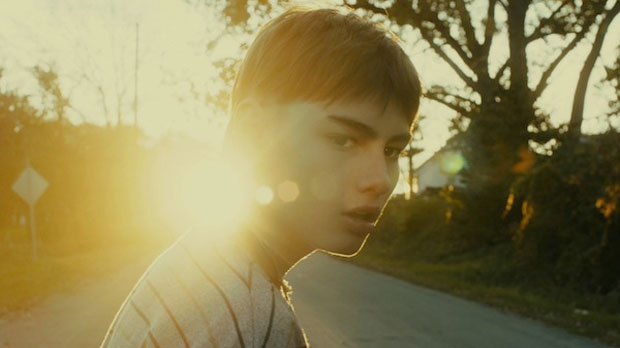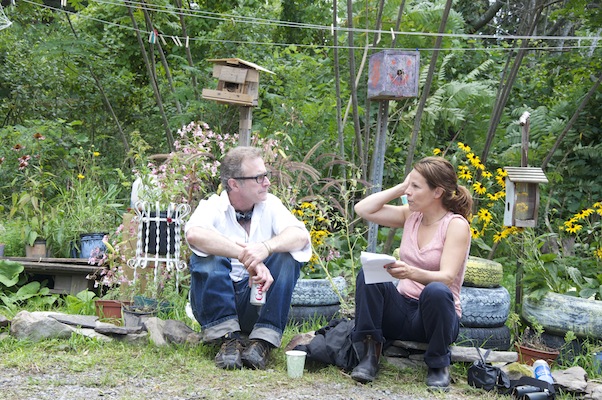 Back to selection
Back to selection
Five Questions with The Cold Lands Director Tom Gilroy
 The Cold Lands
The Cold Lands In 2000, IFC Films released Spring Forward, the first feature directed by actor Tom Gilroy. Starring Ned Beatty and Liev Schreiber, it’s a quiet, unassuming film full of carefully observed interpersonal intricacies, focusing on the growth of the two men’s relationship over the course of a year while they work for the Parks Department in a small Connecticut town. One of the smartest, subtlest indie films of its era, Spring Forward won awards and an impressive array of rave reviews. Nevertheless, it took Gilroy nearly a decade to get going on his second feature, The Cold Lands, which is only just making the festival rounds now. “It wasn’t for lack of trying in between there,” says Gilroy. “My partner Paul Mezey and I had several projects set up that came and went — the industry changed, and you know, you have something set up at HBO and six months into the project all the people that you set it up with are fired or something changes and before you know it you turn around and nine years have gone by. I did a lot of stuff in those nine years, but I didn’t make any features.”
Another film intensely focused on the most intimate activities and exchanges of its main characters, The Cold Lands is a worthy successor to Spring Forward, but follows a far different path. It’s centered on the lives of Nicole (Lili Taylor) and her adolescent son, Atticus (Silas Yelich), who carve out a fiercely independent life in a rural, upstate New York town, living mostly “off the grid” out of some combination of poverty and Nicole’s noncomformist principles. When circumstances push Silas to extremes, the story itself goes off the grid, and following it is a simultaneously thrilling and illuminating experience.
The Cold Lands makes its New York premiere at BAMcinemaFest on June 23.
Filmmaker: What were the circumstances that finally led you to follow up Spring Forward with The Cold Lands?
Gilroy: Both films were made at the urging of Jim McKay, my best friend, who’s also a filmmaker. Spring Forward rose out of two ideas: one was this kind of ongoing comedy routine that I used to do with Jim McKay about an old guy and a younger guy kind of bulshitting. [Also] My mom was dying and I started to spend a lot of time with my dad. He’s not unlike the Murph character [Ned Beatty] in some ways. I began to see these two ideas merging and I kept saying to Jim, “I think there’s a movie here.” And finally Jim and [R.E.M. singer] Michael Stipe, they had a company together, and they said, “It’s time to make the movie about the two guys.”
Flash forward nine years, and Jim McKay called me up and said, “Look, how many times are you gonna go through this ‘This thing’s in development and then it falls apart’ routine…you have to just sit down and make it right away. Do something that you can do on your friends’ property, and figure it out.” So I was living up here in the Catskills, and I live next to a nature preserve. I had some ideas for several movies but I had one for a very, very small budget that I wanted to make that had to do with the things that The Cold Lands is about. It was originally gonna be a kind of Tsai Ming Liang-style one-shot-per-scene kind of movie, largely improvised, with no script and a crew of nine people. We were ready to go with that…and then at the last minute Cinereach came in and said, “We really love this idea and we’d like to help you make the film.” The only requirement they had was, “Could we see a script?” [Laughs]. I had the ideas in my head and I’d been working with Silas in improv for a year, so I banged out a script for them and we went forward.
Filmmaker: How did you find Silas Yelich?
Gilroy: I knew I wanted a real kid and not an actor kid. I went to some high schools and elementary schools and saw the productions of Guys and Dolls and all that stuff, but right in my town they were doing this production of Willy Wonka. Silas lives at the bottom of my hill. I went to see some rehearsals of the play and I noticed Silas. He didn’t even have a part, but he was in one of the crowd scenes. I just thought, “This kid has an interesting face. Let me go talk to him.” He would not speak to me. So I met with the parents, and we decided to go down this path. We did a bunch of acting exercises…he just skated through amazingly, he had this natural knack for it. We made an agreement to meet every two weeks for a couple of hours. In total we worked for about a year. I began to improv with him on story elements and draw elements of the character of Atticus out of his life. He had no acting experience whatsoever.
Filmmaker: Where did the idea for Nicole and Silas’s lifestyle come from?
Gilroy: The idea for all of the people and all of the situations in the movie came from the town where I live, to kind of use as a prism for things that I’m observing about the country at large. The way that they live, Nicole and Silas, is not all that unusual in mainstream America. There are a lot of people that live in trailers that are falling apart or houses that were sitting vacant. For me what makes the character of Nicole poetic is that she’s also trying to add a level of philosophy and organization that keeps her a level above abject poverty, and there’s a code of ethics behind it. There are many people who live up here in log cabins and houses with no heat, or they’re off the electrical grid, or they grow all their own food. They’re not all hippies, some of them are just poor.

Filmmaker: What were the larger ideas you were trying to express through these characters?
Gilroy: I would never set out to write a specifically political movie…but in addition to very obvious topical things that are going on the United States, like the utter collapse of the social safety net, philosophically I was interested in exploring this idea of American rebel spirit…pull yourself up by the bootstraps…this kind of idea of American go-it-alone mythology, which is so wrapped up in our national identity, and I just think it’s crap. In reality nobody stands on our own; we all need each other. We all have to help one another. Society would collapse if everybody went their own way. So I thought it would be interesting to deal with some of those issues. In the case of the mother, it’s someone who, for many reasons — self-respect, societal judgement — doesn’t want any help from anyone. And of course the child becomes the product of a society that’s going through what I described, slamming up against the mythology I just described.
Filmmaker: There are some surface commonalities between Spring Forward and The Cold Lands, but what would you say is the most obvious difference?
Gilroy: When it gets down to the nitty gritty, the things that usually interest me are very small moments and very quotidian lives that would otherwise be considered uneventful…I like the idea of micro-focusing on the minutiae of someone’s life, and stringing a lot of those moments together so that it ends up — slowly, with momentum — packing an emotional punch that you as an audience weren’t aware you were being led to. In The Cold Lands I was much more conscious of trying to use a pure cinematic language that wasn’t so heavily influenced by my origins in the theater, hence the entire middle section, which has almost no dialogue whatsoever. I wanted to see, “Can I get away with this? Can I push this envelope?” I want to see some silence; a lot of movies right now, it seems like the idea of making a beautiful image and taking your time and trying to render something elegant might be, at least in the independent world, kind of slipping away. There are a lot of films coming out where the look doesn’t really matter…if you’ve got it on film and it’s kind of in focus, then okay. You know, if you’re gonna get a bunch of people in a room and turn the lights down, then let’s make it beautiful.
